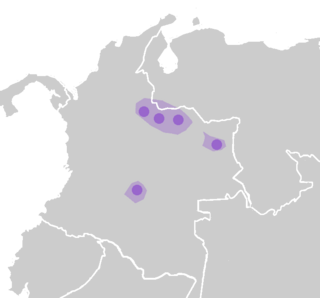
The Arawak are a group of Indigenous peoples of northern South America and of the Caribbean. The term "Arawak" has been applied at various times to different Indigenous groups, from the Lokono of South America to the Taíno, who lived in the Greater Antilles and northern Lesser Antilles in the Caribbean. All these groups spoke related Arawakan languages.

The Kalinago, also called Island Caribs or simply Caribs, are an Indigenous people of the Lesser Antilles in the Caribbean. They may have been related to the Mainland Caribs (Kalina) of South America, but they spoke an unrelated language known as Kalinago or Island Carib. They also spoke a pidgin language associated with the Mainland Caribs.

Macro-Arawakan is a proposed language family of South America and the Caribbean centered on the Arawakan languages. Sometimes, the proposal is called Arawakan, and the central family is called Maipurean.

The Cariban languages are a family of languages indigenous to north-eastern South America. They are widespread across northernmost South America, from the mouth of the Amazon River to the Colombian Andes, and they are also spoken in small pockets of central Brazil. The languages of the Cariban family are relatively closely related. There are about three dozen, but most are spoken only by a few hundred people. Macushi is the only language among them with numerous speakers, estimated at 30,000. The Cariban family is well known among linguists partly because one language in the family—Hixkaryana—has a default word order of object–verb–subject. Prior to their discovery of this, linguists believed that this order did not exist in any spoken natural language.

Arawak, also known as Lokono, is an Arawakan language spoken by the Lokono (Arawak) people of South America in eastern Venezuela, Guyana, Suriname, and French Guiana. It is the eponymous language of the Arawakan language family.

Je–Tupi–Carib is a proposed language family composed of the Macro-Je, Tupian and Cariban languages of South America. Aryon Rodrigues (2000) based this proposal on shared morphological patterns. In an earlier proposal, Rodrigues (1985) had also proposed a Tupí-Cariban language family.
At the time of first contact between Europe and the Americas, the Indigenous peoples of the Caribbean included the Taíno of the northern Lesser Antilles, most of the Greater Antilles and the Bahamas, the Kalinago of the Lesser Antilles, the Ciguayo and Macorix of parts of Hispaniola, and the Guanahatabey of western Cuba. The Kalinago have maintained an identity as an Indigenous people, with a reserved territory in Dominica.
Garifuna (Karif) is a minority language widely spoken in villages of Garifuna people in the western part of the northern coast of Central America.

Arawakan, also known as Maipurean, is a language family that developed among ancient indigenous peoples in South America. Branches migrated to Central America and the Greater Antilles and Lesser Antilles in the Caribbean and the Atlantic, including what is now the Bahamas. Almost all present-day South American countries are known to have been home to speakers of Arawakan languages, the exceptions being Ecuador, Uruguay, and Chile. Maipurean may be related to other language families in a hypothetical Macro-Arawakan stock.
The Igneri were an Indigenous Arawak people of the southern Lesser Antilles in the Caribbean. Historically, it was believed that the Igneri were conquered and displaced by the Island Caribs or Kalinago in an invasion some time before European contact. However, linguistic and archaeological studies in the 20th century have led scholars to more nuanced theories as to the fate of the Igneri. The Igneri spoke an Arawakan language which transitioned into the Kalinago language.

Guajiboan is a language family spoken in the Orinoco River region in eastern Colombia and southwestern Venezuela, a savanna region known as the Llanos.
The Arawak are an indigenous people of South America, and historically of the Caribbean.
The Piro languages, a.k.a. Purus, or in Aikhenvald South-Western Arawak, are Arawakan languages of the Peruvian and western Brazilian Amazon.

Taíno is an Arawakan language formerly spoken widely by the Taíno people of the Caribbean. In its revived form, there exist several modern-day Taíno language variants including Hiwatahia-Taino and Tainonaiki. At the time of Spanish contact it was the most common language throughout the Caribbean. Classic Taíno was the native language of the Taíno tribes living in the Leeward Islands of the Lesser Antilles, Borikén, the Turks and Caicos Islands, most of Ayiti-Kiskeya also known as Hispaniola, and eastern Cuba. The Ciboney dialect is essentially unattested, but colonial sources suggest it was very similar to Classic Taíno, and was spoken in the westernmost areas of Hispaniola, the Bahamas, Jamaica, and most of Cuba.

Several languages of the Greater Antilles, specifically in Cuba and Hispaniola, appear to have preceded the Arawakan Taíno. Almost nothing is known of them, though a couple recorded words, along with a few toponyms, suggest they were not Arawakan or Cariban, the families of the attested languages of the Antilles. Three languages are recorded: Guanahatabey, Macoris, and Ciguayo.

The Kalinago language, also known as Island Carib and Igneri, was an Arawakan language historically spoken by the Kalinago of the Lesser Antilles in the Caribbean. Kalinago proper became extinct by about 1920 due to population decline and colonial period deportations resulting in language death, but an offshoot survives as Garifuna, primarily in Central America.

Caquetío, also called Caquetío Arawak, is an extinct Arawakan language. The language was spoken along the shores of Lake Maracaibo, in the coastal areas of the Venezuelan state of Falcón, and on the Dutch islands of Aruba, Bonaire and Curaçao. It is referred to as a "ghost language" because no tangible evidence of it remains. Only the name still exists, as mentioned in references from 17th-century texts.
The Lokono or Arawak are an Arawak people native to northern coastal areas of South America. Today, approximately 10,000 Lokono live primarily along the coasts and rivers of Guyana, with smaller numbers in Venezuela, Suriname, French Guiana. They speak the Arawak language, the eponymous language of the Arawakan language family, as well as various Creole languages, and English.









